Deza M.M., Laurent M. Geometry of Cuts and Metrics
Подождите немного. Документ загружается.

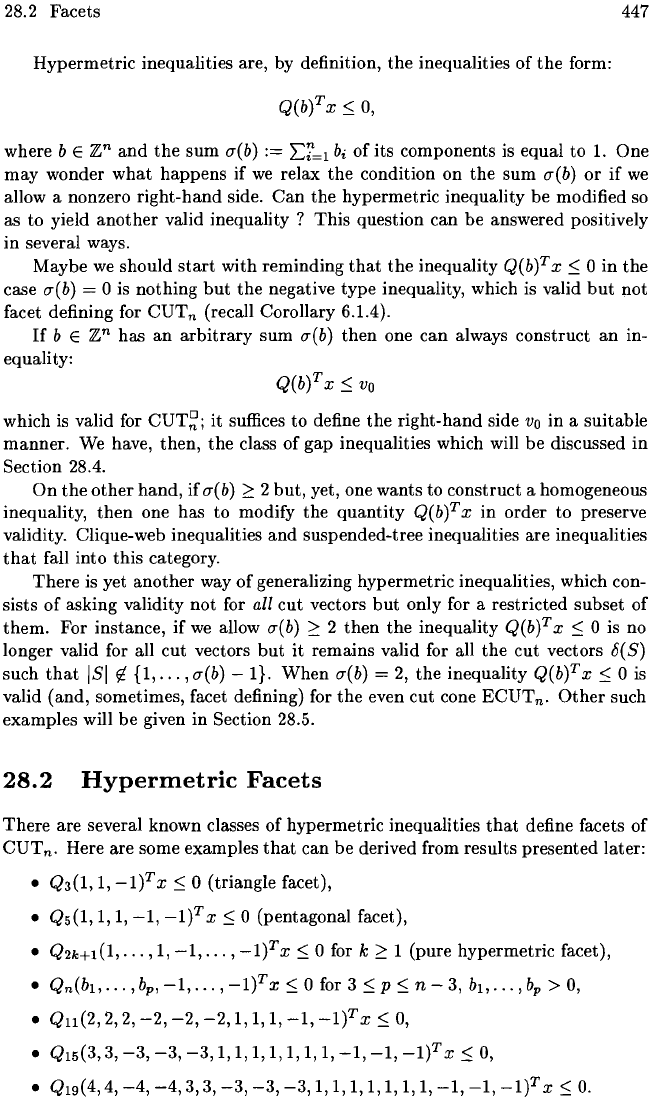
28.2 Facets
447
Hypermetric
inequalities are, by definition,
the
inequalities
of
the
form:
Q(bfx
~
0,
where b E
zn
and
the
sum
O"(b)
:=
Ei'=l
bi
of
its
components is equal
to
1.
One
may
wonder
what
happens
if
we
relax
the
condition
on
the
sum
O"(b)
or
if
we
allow a nonzero
right-hand
side.
Can
the
hypermetric
inequality be modified so
as to yield
another
valid
inequality?
This
question can
be
answered positively
in
several ways.
Maybe
we
should
start
with reminding
that
the
inequality Q(b)T x
~
°
in
the
case
O"(b)
= ° is nothing
but
the
negative
type
inequality, which is valid
but
not
facet defining for
CUTn
(recall Corollary 6.1.4).
If
b E
zn
has
an
arbitrary
sum
O"(b)
then
one
can
always
construct
an
in-
equality:
which
is
valid for
CUT~;
it
suffices to define
the
right-hand
side
Va
in
a
suitable
manner.
We have,
then,
the
class
of
gap
inequalities which will be discussed
in
Section 28.4.
On
the
other
hand,
if
O"(b)
::::
2
but,
yet, one wants to
construct
a homogeneous
inequality,
then
one
has
to modify
the
quantity
Q(b)T x
in
order
to preserve
validity. Clique-web inequalities
and
suspended-tree inequalities are inequalities
that
fall into
this
category.
There
is yet
another
way
of
generalizing hypermetric inequalities, which con-
sists
of
asking validity
not
for all
cut
vectors
but
only for a
restricted
subset
of
them.
For instance,
if
we
allow
O"(b)
::::
2
then
the
inequality Q(b)T x
~
° is no
longer valid for all
cut
vectors
but
it
remains valid for all
the
cut
vectors
8(8)
such
that
181
ft
{I,
...
,
O"(b)
- I}.
When
O"(b)
=
2,
the
inequality Q(b)T x
~
°
is
valid
(and,
sometimes, facet defining) for
the
even
cut
cone
ECUT
n
.
Other
such
examples will
be
given in Section 28.5.
28.2
Hypermetric
Facets
There
are several known classes
of
hypermetric
inequalities
that
define facets
of
CUT
n
. Here are some examples
that
can
be
derived from results
presented
later:
• Q3(1, 1,
_1)T
x
~
° (triangle facet),
• Q5(1, 1,
1,
-1,
_1)T
x
~
° (pentagonal facet),
• Q2k+l(I,
...
, 1,
-1,
...
,
-If
x
~
° for k
::::
1 (pure
hypermetric
facet),
• Qn(b
1
,
...
,b
p
,-I,
...
,-I)T
x
~
° for 3
~p
~
n-3,
b1,
...
,b
p
> 0,
•
Qn(2,
2, 2,
-2,
-2,
-2,1,1,1,
-1,
_1)T
x
~
0,
• Q15(3, 3,
-3, -3,
-3,
1, 1, 1, 1, 1,
1,
1,
-1, -1,
_1)T
x
~
0,
• Q19(4, 4,
-4,
-4,3,3,
-3, -3,
-3,
1, 1, 1, 1, 1,
1,
1,
-1, -1,
_1)T
x
~
0.
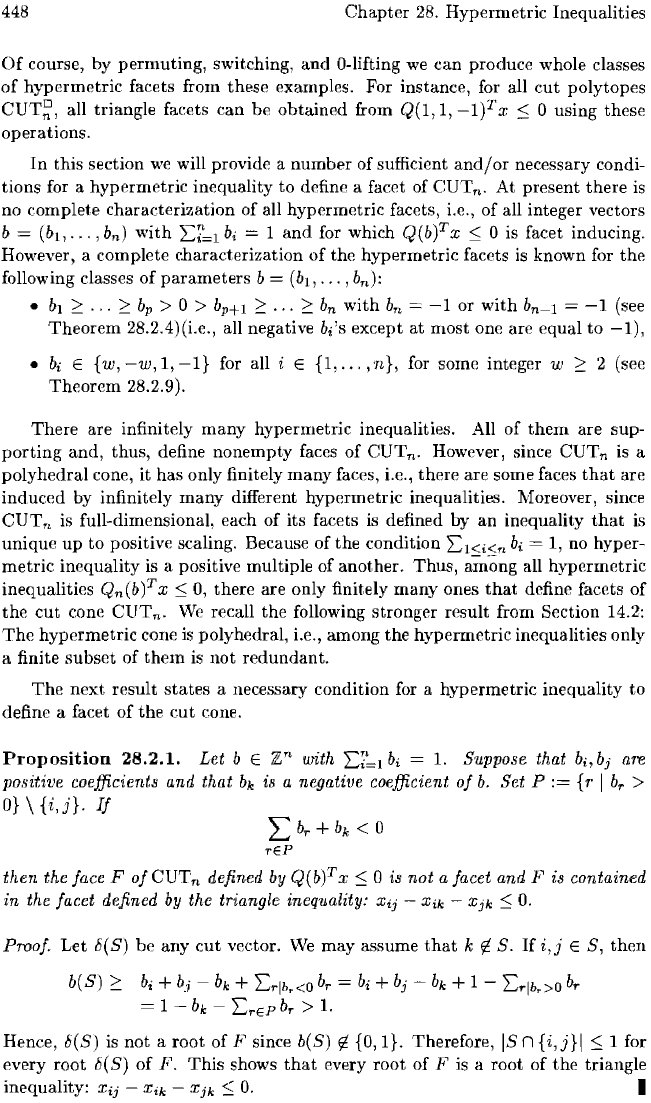
448
Chapter
28. Hypermetric Inequalities
Of
course, by permuting, switching,
and
O-lifting
we
can
produce whole classes
of
hypermetric
facets from these examples. For instance, for all
cut
polytopes
CUT~,
all triangle facets can
be
obtained from
Q(l,
1,
-lfx
s:
0 using these
operations.
In
this section
we
will provide a
number
of sufficient
and/or
necessary condi-
tions for a hypermetric inequality
to
define a facet of
CUT
n
. At present there is
no complete characterization of all hypermetric facets, i.e., of all integer vectors
b = (bl,
...
, b
n
)
with
L:'=l
b;
= 1
and
for which Q(b)T x
s:
0 is facet inducing.
However, a complete characterization
of
the
hypermetric facets
is
known for
the
following classes of
parameters
b =
(b
1
,
.•.
, b
n
):
• b
1
;:::
.•.
;:::
b
p
> 0 > b
p
+
1
;:::
•••
;::: b
n
with
b
n
-lor
with
-1
(see
Theorem
28.2.4)(i.e., all negative
bi'S
except at most one are equal
to
-1),
• b
i
E
{w,-w,I,-l}
for all i E
{l,
...
,n},
for some integer
w;:::
2 (see
Theorem
28.2.9).
There are infinitely
many
hypermetric inequalities. All
of
them
are sup-
porting
and, thus, define nonempty faces
of
CUT
n
.
However, since CUTn is a
polyhedral cone,
it
has
only finitely
many
faces, i.e., there are some faces
that
are
induced by infinitely many different hypermetric inequalities. Moreover, since
CUTn is full-dimensional, each of
its
facets is defined by
an
inequality
that
is
unique
up
to
positive scaling. Because of the condition
b;
1, no hyper-
metric
inequality is a positive multiple of another. Thus, among all
hypennetric
inequalities
Qn
(b)T X
s:
0, there are only finitely many ones
that
define facets
of
the
cut
cone
CUT
n
.
We
recall
the
following stronger result from Section 14.2:
The
hypermetric cone
is
polyhedral, i.e., among the hypermetric inequalities only
a finite
subset
of
them
is
not
redundant.
The
next
result
states
a necessary condition for a hypermetric inequality
to
define a facet
of
the
cut
cone.
Proposition
28.2.1.
Let b E
zn
with
Li~l
b
i
= 1. Suppose that b
i
,
bj
are
positive coefficients and that
bk
iii a negative coefficient
of
b.
Set P
:=
{r I b
r
>
O}
\
{i,j}.
If
L b
r
+b
k
< 0
rEP
then the face F
ofCUTn
defined
by
Q(b)T x
s:
0 iii not a facet and F is contained
in the facet defined
by
the triangle inequality:
Xij
-
Xik
-
Xjk
s:
O.
Proof.
Let
8(S) be any
cut
vector.
We
may
assume
that
k
tf.
s.
If
i,j
E
S,
then
b(S);:::
b;
+ bj b
k
+ Lrlbr<O b
r
b;
+ b
j
bk
+ 1 - Lrlbr>O br
bk
b
r
>
1.
Hence,
8(S)
is
not
a
root
of F since b(S)
tf.
{O,
I}. Therefore,
IS
n {i,j}1
s:
1 for
every root
8(S)
of
F.
This
shows
that
every root
of
F is a root
of
the
triangle
inequality:
Xij
-
Xik
Xjk
s:
O.
I
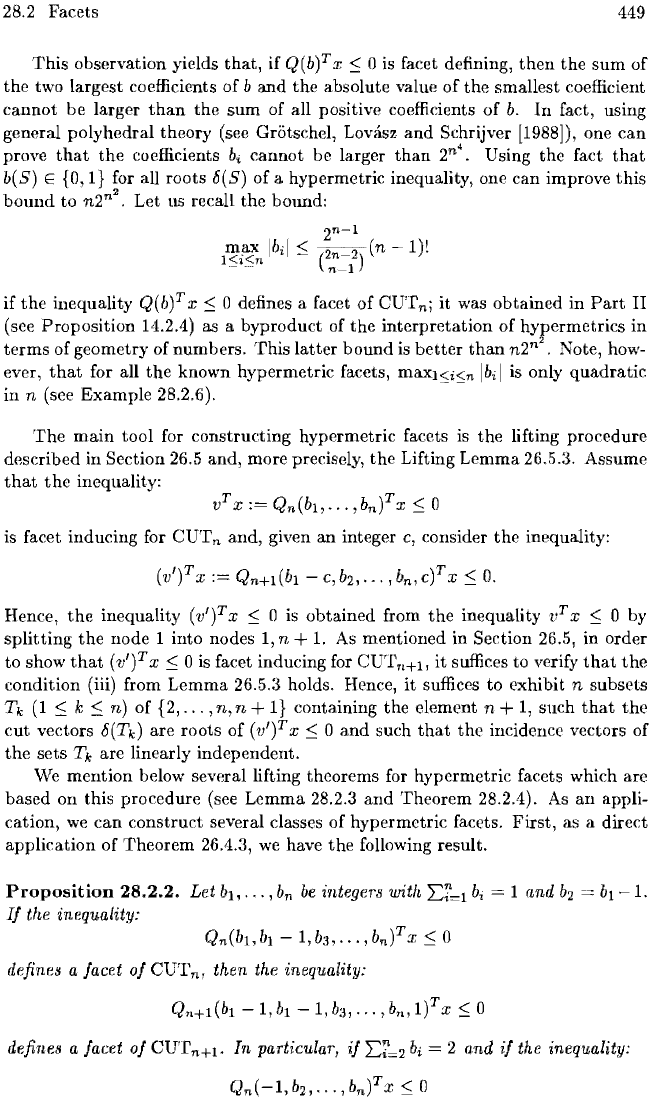
28.2 Facets
449
This
observation yields
that,
if Q(b)T x::; 0 is facet defining,
then
the
sum
of
the two largest coefficients
of
b and the absolute value
of
the
smallest coefficient
cannot
be larger
than
the
sum
of all positive coefficients of
b.
In
fact, using
general polyhedral theory (see Grotschel, Lovasz
and
Schrijver [1988]), one can
prove
that
the
coefficients b
i
cannot be larger
than
2n4. Using the fact
that
b(S) E
{O,
I}
for all roots 6(S) of a hypermetric inequality, one can improve
this
bound
to
n2n2. Let us recall
the
botmd: '
~~In-l)!
if the inequality Q(b)T x::; 0 defines a facet
of
CUTn;
it
was obtained in
Part
II
(see Proposition
14.2..1)
as a byproduct of the interpretation
of
hypermetrics
in
terms
of geometry of numbers. This
latter
bound
is
better
than
n2n2. Note, how-
ever,
that
for all
the
known hypermetric facets, maxl'Si'Sn
Ibil
is only quadratic
in
n (see Example 28.2.6).
The
main tool for constructing hypermetric facets is
the
lifting procedure
described in Section
26.5 and, more precisely,
the
Lifting Lemma 26.5.3. Assume
that
the
inequality:
v
T
x:=
Qn(bl,
...
,bn)T x::; 0
is facet inducing for CUTn and, given an integer c, consider the inequality:
(v'f
x:=
Qn+l(b
1
-
C,b2,.'" bn,c)T x::;
O.
Hence,
the
inequality (v')T x
::;
0
is
obtained from
the
inequality v
T
x
::;
0 by
splitting the node
1 into nodes 1, n +
1.
As
mentioned in Section 26.5, in order
to show
that
(v'f
x
::;
0 is facet inducing for CUTn+l,
it
suffices to verify
that
the
condition (iii) from Lemma 26.5.3 holds. Hence,
it
suffices to exhibit n subsets
Tk
(1
::;
k
::;
n) of
{2,
...
,n,
n + I} containing the element n +
1,
such
that
the
cut
vectors 6(Tk) are roots of
(v'f
x
::;
0 and such
that
the incidence vectors of
the
sets
Tk
are linearly independent.
We
mention below several lifting theorems for hypermetric facets which are
based on this procedure (see Lemma
28.2.3
and
Theorem 28.2.4).
As
an
appli-
cation,
we
can construct several classes of hypermetric facets. First, as a direct
application of Theorem
26.4.3,
we
have the following result.
Proposition
28.2.2.
Let b
1
,
...
,b
n
be
integers with
If
the inequality:
Qn(b
ll
b
1
1,
b3,
.
..
,bn)T x
::;
0
defines a facet
of
CUT
n1
then the inequality:
bi
1 and
b2
b
1
1.
Qn+l(b
1
l,bl
l,ba,
...
,b
n
,l)T
X
::;O
defines a facet
of
CUTn+l'
In
particular,
if
bi
= 2 and
if
the inequality:
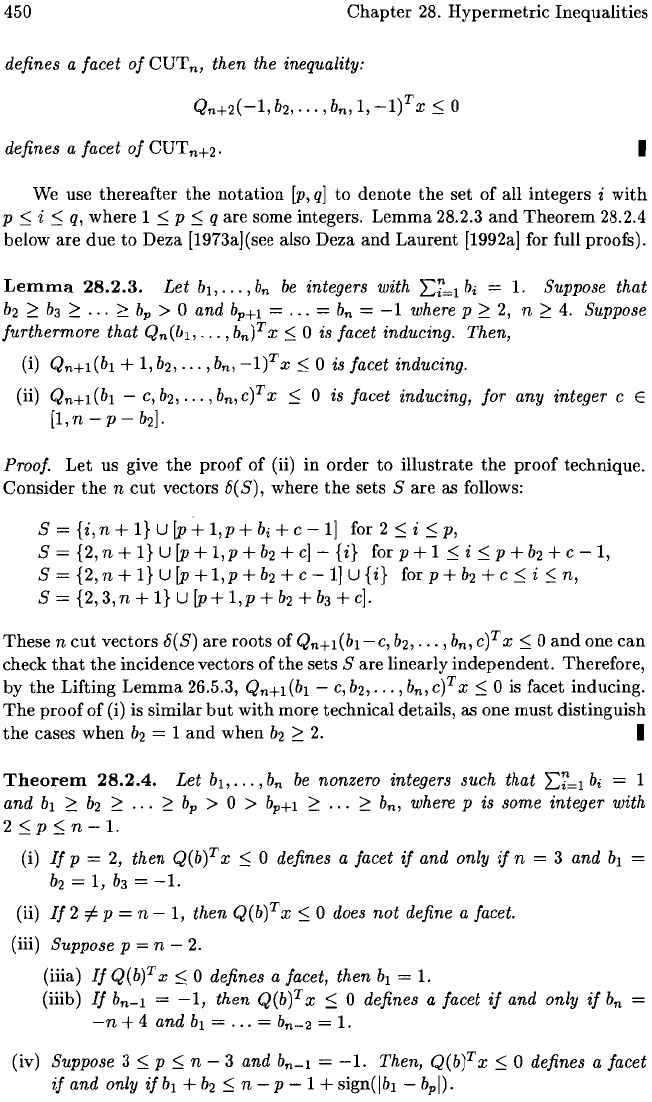
450
Chapter
28.
Hypermetric
Inequalities
defines a
facet
of
CUT
n
,
then
the inequality:
defines a
facet
of
CUT
n+2.
I
We use
thereafter
the
notation
[p,
q]
to denote
the
set
of
all integers i
with
p
:::;
i
:::;
q,
where 1
:::;
p
:::;
q are some integers.
Lemma
28.2.3
and
Theorem
28.2.4
below are
due
to Deza [1973a](see also Deza
and
Laurent
[1992a] for full proofs).
Lemma
28.2.3.
Let
bl,
...
, b
n
be
integers with
E?=l
b
i
= 1. Suppose
that
b
2
2:
b
3
2:
...
2:
b
p
> 0
and
b
p
+
1
=
...
= b
n
=
-1
where p
2:
2,
n
2:
4.
Suppose
furthermore
that
Qn(b
1
,
•••
,
bnf
x
:::;
0 is
facet
inducing. Then,
(i)
Qn+l(b
1
+
1,
b
2
,
...
, b
n
,
-If
x:::;
0 is
facet
inducing.
(ii)
Qn+l
(b
1
-
C, b
2
,
...
, b
n
,
cf
x
:::;
0 is
facet
inducing,
for
any
integer
c E
[1,n-p-
b
2].
Proof.
Let
us give
the
proof
of
(ii)
in
order
to
illustrate
the
proof
technique.
Consider
the
n
cut
vectors 6(8), where
the
sets 8
are
as follows:
8 = {i, n +
I}
u
[p
+ 1, p + b
i
+ C -
1]
for 2
:::;
i
:::;
p,
8 = {2, n +
I}
U
[p
+
l,p
+ b
2
+
c]-
{i}
for p + 1
:::;
i
:::;
p + b
2
+ C - 1,
8 = {2, n +
I}
U
[p
+ 1, p + b
2
+ c -
1]
U { i } for p +
b2
+ c
:::;
i
:::;
n,
8 = {2,
3,
n + I} U
[p
+
l,p
+ b
2
+
b3
+
c].
These
n
cut
vectors 8(8) are roots of
Qn+l(b1-c,
b
2
,
•••
, b
n
,
cf
x:::; 0
and
one
can
check
that
the
incidence vectors
of
the
sets 8 are linearly
independent.
Therefore,
by
the
Lifting
Lemma
26.5.3, Qn+l
(b
1
-
C,
b
2
,
•••
,b
n
,
cf
x:::;
0
is
facet inducing.
The
proof
of
(i) is similar
but
with
more technical details, as one
must
distinguish
the
cases
when
b
2
= 1
and
when
b2
2:
2.
I
Theorem
28.2.4.
Let
bl,
...
,b
n
be
nonzero
integers
such
that
E?=l
bi
= 1
and
b
1
2:
b2
2:
...
2:
b
p
> 0 > b
p
+
1
2:
...
2:
b
n
, where p is
some
integer
with
2:::;p:::;n-1.
(i)
If
p =
2,
then
Q(bf
x
:::;
0 defines a facet
if
and
only
if
n = 3
and
b
1
=
b
2
= 1, b
3
=
-1.
(ii)
If
2
=1=
p = n - 1,
then
Q(bf
x
:::;
0 does
not
define a facet.
(iii) Suppose p = n - 2.
(iiia)
If
Q(
b f x
:::;
0 defines a facet,
then
b
1
= 1.
(iiib)
If
b
n
-
1
=
-1,
then
Q(b
f x
:::;
0 defines a
facet
if
and
only
if
b
n
-n
+ 4
and
b
1
=
...
= b
n
-2
= 1.
(iv) Suppose 3:::;
p:::;
n - 3
and
b
n
-
1
=
-1.
Then,
Q(bfx:::;
0 defines a
facet
if
and
only
if
b
1
+ b
2
:::;
n - p - 1 + sign(lb
l
- bpi)·
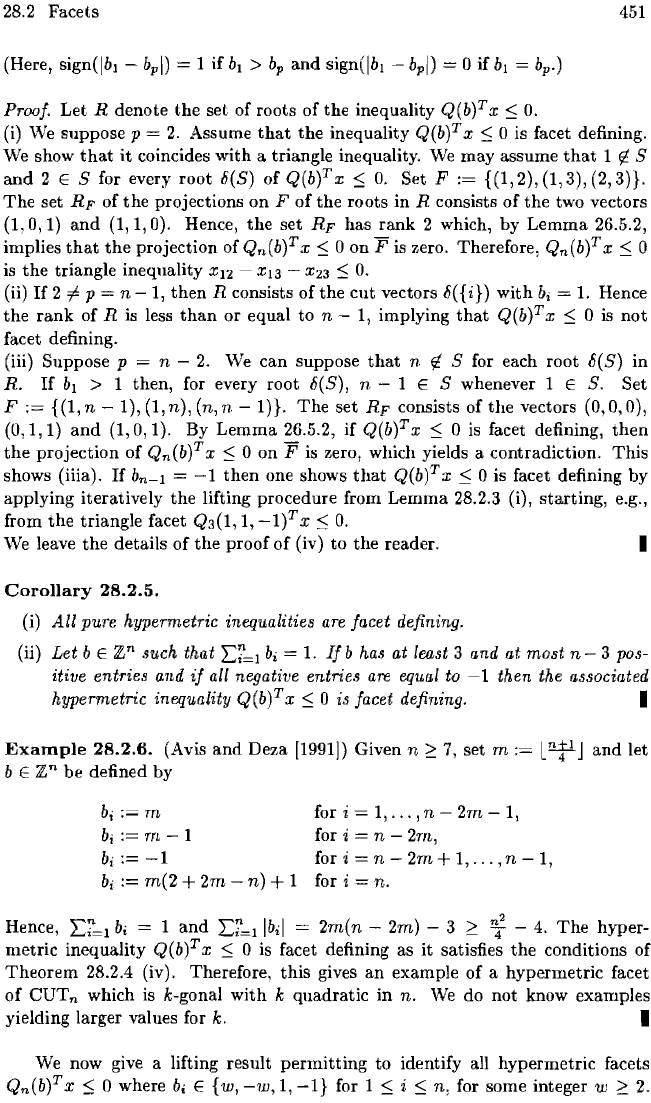
28.2 Facets
451
Proof.
Let
R denote
the
set
ofroots
of
the
inequality Q(b)T
x:::;
O.
(i) We
suppose
p =
2.
Assume
that
the
inequality Q(b)T x
:::;
0 is facet defining.
We show
that
it
coincides
with
a triangle inequality.
We
may
assume
that
1
f/.
S
and
2 E S for every
root
Ii(S) of
Q(b)T
x
:::;
O.
Set F
:=
{(I,
2), (1, 3), (2, 3)}.
The
set
Rp
of
the
projections
on
F
of
the
roots
in
R consists
of
the
two vectors
(1,0,1)
and
(1,1,0).
Hence,
the
set Rp
has
rank
2 which,
by
Lemma
26.5.2,
implies
that
the
projection
of
Qn(b)T
x:::; 0 on F is zero. Therefore,
Qn(b)T
x
:::;
0
is
the
triangle inequality X12
XI3
- XZ3
:::;
O.
(ii)
If
2
=I
p = n - 1,
then
R consists
of
the
cut
vectors Ii( {i})
with
bi
=
1.
Hence
the
rank
of
R is less
than
or
equal
to
n
1,
implying
that
Q(b)T x
:::;
0 is
not
facet defining.
(iii) Suppose
p = n -
2.
We
can
suppose
that
n
f/.
S for each
root
Ii(S) in
R.
If
b
i
> 1 then, for every
root
Ii(S), n - 1 S whenever 1 E
S.
Set
F:=
{(1,n
-I),(I,n),(n,n
-I)}.
The
set Rp consists
of
the
vectors
(0,0,0),
(0,1,1)
and
(1,0,1).
By
Lemma
26.5.2,
if
Q(b)T x
:::;
0 is facet defining,
then
the
projection
of
Qn(b)T
x
:::;
0 on F is zero, which yields a contradiction.
This
shows (iiia).
If
b
n
-
1
=
-1
then
one shows
that
Q(b)T
x
::;
0 is facet defining
by
applying iteratively
the
lifting procedure from
Lemma
28.2.3 (i),
starting,
e.g.,
from
the
triangle facet
Q3(I,
1,
_l)T
x
:::;
O.
We leave
the
details
of
the
proof
of
(iv)
to
the
reader. I
Corollary
28.2.5.
(i)
All
pure hypermetric inequalities are facet defining.
(U)
Let
b E zn such that
E:=1
bi
= 1.
If
b has at least 3 and at
most
n 3 pos-
itive entries and
if
all negative entries
are
equal to
-1
then the associated
hypermetric inequality
Q(b)T x:::; 0 is facet defining. I
Example
28.2.6.
(Avis
and
Deza [1991]) Given n
;:::
7, set m
:=
L!1f'
J
and
let
b E
zn
be
defined
by
m
m-I
-1
m(2+2m
for i =
1,
...
, n -
2m
- 1,
for
i = n -
2m,
for i = n -
2m
+ 1,
...
, n - 1,
n) + 1 for i = n.
2
Hence,
bi
1
and
Ei=llbil
2m(n - 2m) - 3
;:::
T -
4.
The
hyper-
metric
inequality Q(b)T x
:::;
0 is facet defining as
it
satisfies
the
conditions
of
Theorem
28.2.4 (iv). Therefore,
this
gives
an
example
of
a hypermetric facet
of
CUTn
which is k-gonal
with
k quadratic
in
n.
We
do
not
know examples
yielding larger values for
k. I
We now give a lifting result
permitting
to
identify all
hypermetric
facets
Qn(b)Tx:::; 0 where
bi
E
{w,-w,I,-I}
for 1:::;
i:::;
n, for some integer w
;:::
2.
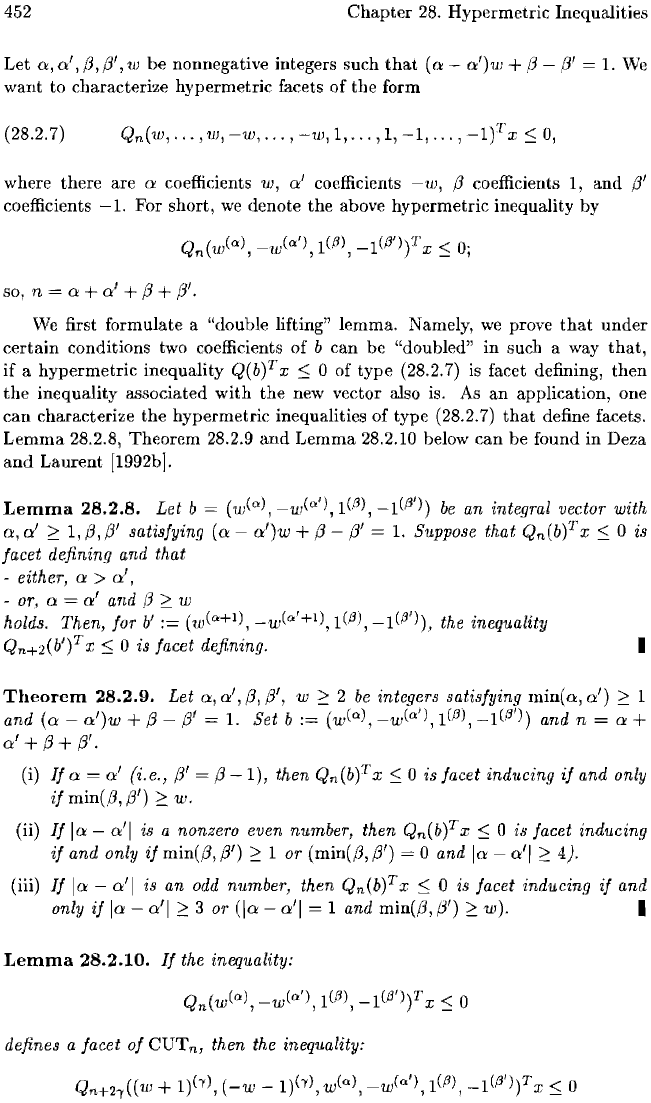
452
Chapter
28.
Hypermetric Inequalities
Let
0:,
ci,
,8,
(3',
w
be
nonnegative integers such
that
(0:
o:')w +
(3
(3'
= L
'We
want to characterize hypermetric facets
of
the
form
(28.2.7)
Qn(w,
.
..
, w,
-w,
..
. ,
-w,
1,
...
, 1,
-1,
...
,
:s
0,
where there are a coefficients w,
0:'
coefficients
-w,
(3
coefficients 1,
and
(3'
coefficients
-1.
For short,
we
denote
the
above hypermetric inequality by
so, n
= a +
a'
+
(3
+
(3'.
We
first formulate a "double lifting" lemma. Namely,
we
prove
that
under
certain
conditions two coefficients of b can be "doubled"
in
such a way
that,
if
a hypermetric inequality Q(b)T x
:s
0 of
type
(28.2.7)
is
facet defining,
then
the
inequality associated
with
the
new vector also is.
As
an
application, one
can
characterize
the
hypermetric inequalities of type (28.2.7)
that
define facets.
Lemma
28.2.8, Theorem 28.2.9
and
Lemma
28.2.10 below
can
be
found in Deza
and
Laurent
[1992b].
Lemma
28.2.8.
Let
b (w(a),
-w(a
l
),
1
Ul),
-1
Cfl
f
»)
be
an integral vector with
0:,
a'
1,
(3,
(3'
satisfying
(a
a')w
+
(3
-
(3'
= 1. Suppose
that
Qn(b)TX
:s
0 is
facet defining and
that
either,
0:
>
a',
- or, a
0:'
and
(3
:2::
w
holds. Then, for
b'
:=
(w(a+1) ,
_w(a'H),
1 (fl),
-1
(fll»), the inequality
Qn+2(b')T
x
:s
0 is facet defining. I
Theorem
28.2.9.
Let
a,
a',
(3,
(3',
w:2::
2
be
integers satisfying
min(o:,a')
1
and
(0:
o:')w +
(3
-
(3'
= 1.
Set
b
:=
(w(a), _w(al),
l(fl)
,
-l(fll»)
and n
0:
+
0:'
+
(3
+
(3'
.
(i)
If
0:
0:'
(i.e.,
(3/
=
(3
-1),
then Qn(b)T x
:s
0 is facet ind1Lcing
if
and only
if
min«(3,
(3')
:2::
w.
(ii)
If
10:
0:/1
is a nonzero even number, then Qn(b)T x
:s
0
i.~
facet inducing
if
and only
if
min«(3,
,8')
:2::
1 or (min(,8,
,8/)
0 and
10:
0:/1:2::
4).
(iii)
If
la -
0:/1
is an
odd
number, then Qn(b)T x
:s
0 is facet inducing
if
and
only
if
10:
-
0:'1
:2::
3 or
(10:
-
0:/1
= 1 and
min«(3,
(3')
:2::
w).
I
Lemma
28.2.10.
If
the ineq1Lality:
Qn(w(a),
_w(a'),
l(fl)
,
_l(fll»)T
x
:s
0
defines a facet
of
CUT
n, then the inequality:
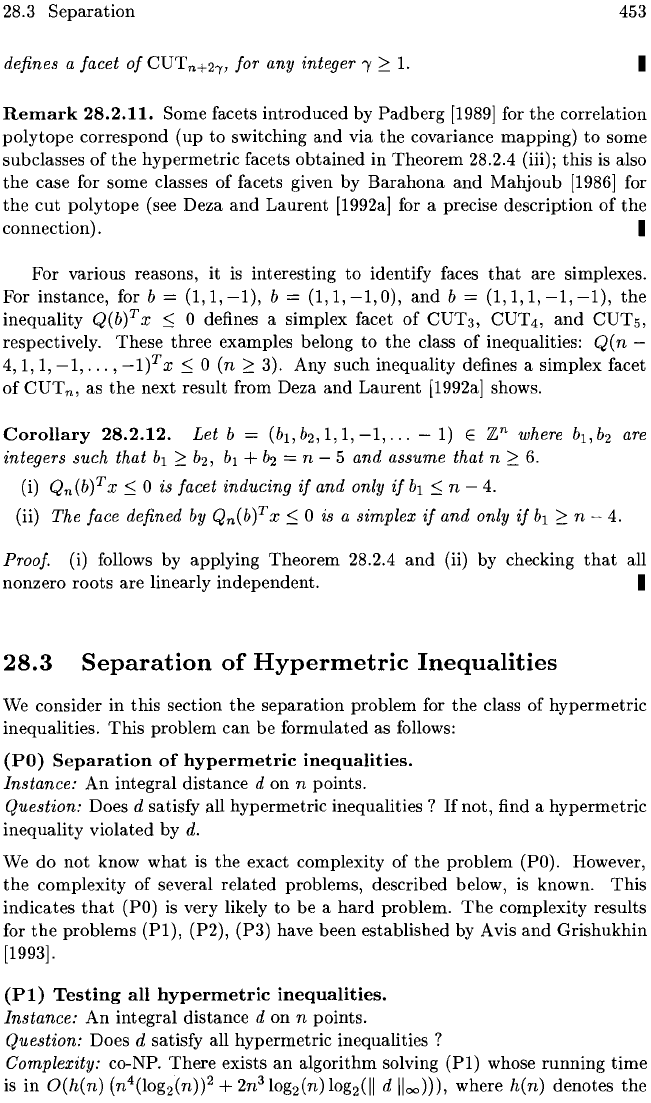
28.3
Separation
453
defines a facet
of
CUT
n
+2op
for
any
integer
l'
~
1.
I
Remark
28.2.11.
Some facets introduced by
Padberg
[1989]
for
the
correlation
polytope
correspond
(up
to
switching
and
via
the
covariance
mapping)
to
some
subclasses
of
the
hypermetric
facets
obtained
in
Theorem
28.2.4 (iii);
this
is
also
the
case for some classes
of
facets given by
Barahona
and
Mahjoub
[1986]
for
the
cut
polytope
(see Deza
and
Laurent
[1992a] for a precise description
of
the
connection). I
For various reasons, it
is
interesting
to
identify faces
that
are simplexes.
For instance, for
b =
(1,1,-1),
b =
(1,1,-1,0),
and
b =
(1,1,1,-1,-1),
the
inequality
Q(b)T
x
~
0 defines a simplex facet
of
CUT
3
,
CUT
4
,
and
CUT
5
,
respectively.
These
three
examples belong to
the
class
of
inequalities:
Q(n-
4,1,1,
-1,
...
, _1)T X
~
0
(n
~
3). Any such inequality defines a simplex facet
of
CUT
n
,
as
the
next result from Deza
and
Laurent
[1992a] shows.
Corollary
28.2.12.
Let
b =
(b
1
,
b
2
,
1, 1,
-1,
...
-
1)
E
zn
where b
1
,
b
2
are
integers
such
that
b
1
~
b
2
,
b
1
+ b
2
= n - 5
and
assume
that
n
~
6.
(i)
Qn
(b)T X
~
0 is facet
inducing
if
and
only
if
b
1
~
n - 4.
(ii)
The
face defined by Qn(b)T x
~
0
is
a
simplex
if
and
only
if
b
1
~
n - 4.
Proof. (i) follows by applying
Theorem
28.2.4
and
(ii) by checking
that
all
nonzero
roots
are linearly independent. I
28.3
Separation
of
Hypermetric
Inequalities
We consider in
this
section
the
separation
problem for
the
class of
hypermetric
inequalities.
This
problem
can
be formulated as follows:
(PO)
Separation
of
hypermetric
inequalities.
Instance:
An
integral distance d on n points.
Question: Does d satisfy all
hypermetric
inequalities?
If
not, find a
hypermetric
inequality violated by
d.
We do
not
know
what
is
the
exact complexity of
the
problem
(PO). However,
the
complexity of several
related
problems, described below,
is
known.
This
indicates
that
(PO)
is
very likely to be a
hard
problem.
The
complexity results
for
the
problems
(PI),
(P2), (P3) have been established by Avis
and
Grishukhin
[1993].
(P1)
Testing
all
hypermetric
inequalities.
Instance:
An
integral distance d on n points.
Question: Does d satisfy all
hypermetric
inequalities?
Complexity: co-NP.
There
exists
an
algorithm solving
(PI)
whose
running
time
is
in
O(h(n)
(n
4
(log2(n))2 +
2n
3
log2(n)
log2(11
d
1100)))'
where h(n) denotes
the
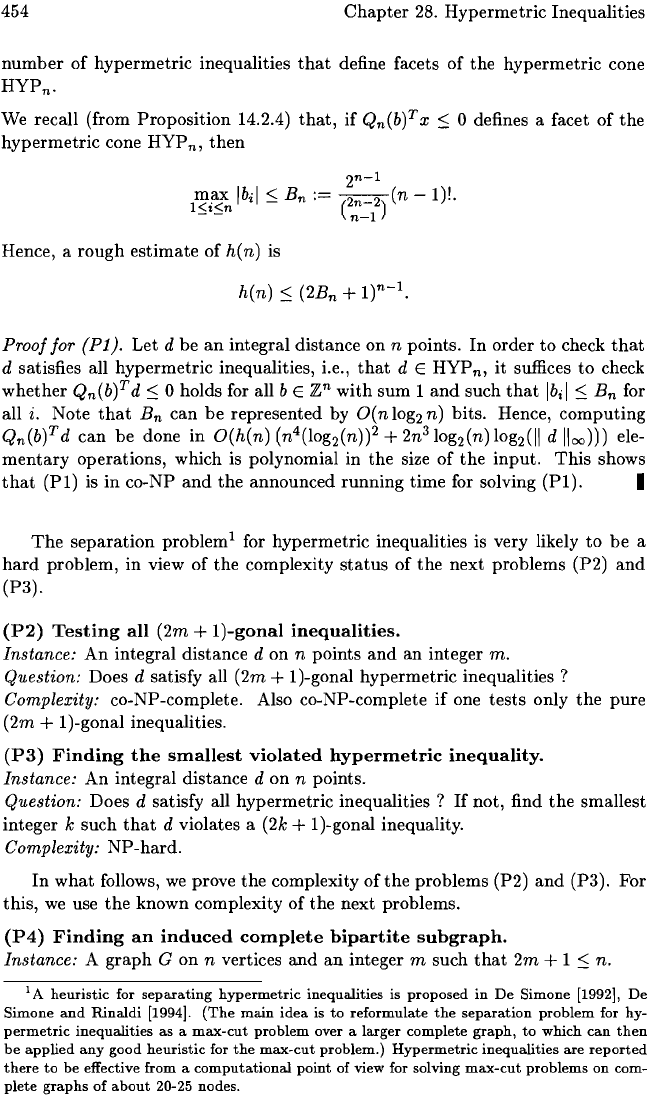
454
Chapter
28.
Hypermetric
Inequalities
number
of
hypermetric
inequalities
that
define facets
of
the
hypermetric
cone
HYP
n
.
We recall (from
Proposition
14.2.4)
that,
if
Qn(bl
x S 0 defines a facet
of
the
hypermetric
cone
HYP
n
,
then
Hence, a
rough
estimate
of
h(n) is
Proof for
(Pl).
Let d be
an
integral distance
on
n points.
In
order
to
check
that
d satisfies all
hypermetric
inequalities, i.e.,
that
d E
HYP
n,
it
suffices
to
check
whether
Qn(bl
d S 0 holds for all b E
zn
with
sum
1
and
such
that
Ibil
S En for
all
i. Note
that
En can
be
represented by O(n
log2
n) bits. Hence,
computing
Qn(bl
d
can
be done
in
O(h(n)
(n
4
(log2(n))2 +
2n
3
Iog2(n)
log2(11
d
11(0)))
ele-
mentary
operations, which is polynomial in
the
size
of
the
input.
This
shows
that
(PI)
is
in
co-NP
and
the
announced
running
time
for solving
(PI).
I
The
separation
problem
l
for
hypermetric
inequalities is very likely
to
be
a
hard
problem, in view
of
the
complexity
status
of
the
next problems (P2)
and
(P3).
(P2)
Testing
all
(2m
+
I)-gonal
inequalities.
Instance:
An
integral distance d on n
points
and
an
integer
m.
Question: Does d satisfy all
(2m
+ I)-gonal
hypermetric
inequalities?
Complexity: co-NP-complete. Also co-NP-complete
if
one
tests
only
the
pure
(2m
+
I)-gonal
inequalities.
(P3)
Finding
the
smallest
violated
hypermetric
inequality.
Instance:
An
integral distance d
on
n points.
Question: Does d satisfy all
hypermetric
inequalities?
If
not,
find
the
smallest
integer
k
such
that
d violates a
(2k
+ I)-gonal inequality.
Complexity:
NP-hard.
In
what
follows,
we
prove
the
complexity
of
the
problems (P2)
and
(P3). For
this,
we
use
the
known complexity
of
the
next problems.
(P4)
Finding
an
induced
complete
bipartite
subgraph.
Instance: A
graph
G
on
n vertices
and
an
integer m such
that
2m
+ 1 S n.
1 A
heuristic
for
separating
hypermetric
inequalities
is
proposed
in
De
Simone
[1992]'
De
Simone
and
Rinaldi
[19941.
(The
main
idea
is
to
reformulate
the
separation
problem
for
hy-
permetric
inequalities
as
a
max-cut
problem
over
a
larger
complete
graph,
to
which
can
then
be
applied
any
good
heuristic
for
the
max-cut
problem.)
Hypermetric
inequalities
are
reported
there
to
be
effective
from
a
computational
point
of
view
for
solving
max-cut
problems
on
com-
plete
graphs
of
about
20-25
nodes.
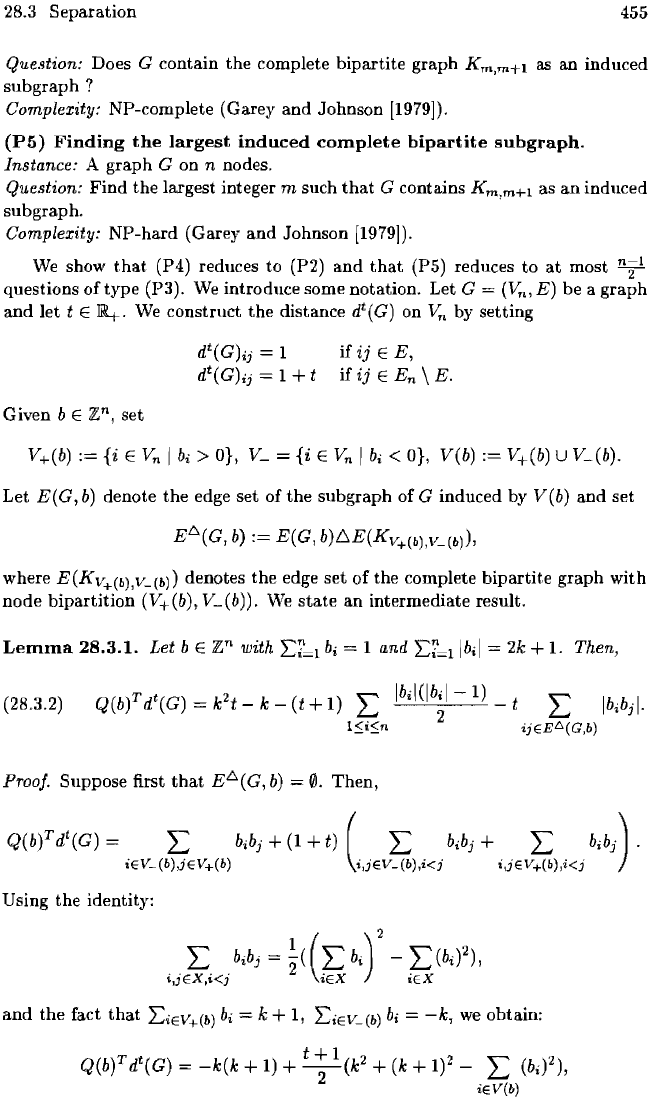
28.3 Separation
455
Que.stion: Does G contain the complete bipartite
graph
Km,m+l
as an induced
subgraph?
Complexity: NP-complete (Garey and Johnson [1979]).
(P5)
Finding
the
largest
induced
complete
bipartite
subgraph.
Instance: A graph G on n nodes.
Question:
Find
the largest integer m such
that
G contains K
m
,m+1 as
an
induced
subgraph.
Complexity: NP-hard (Garey
and
Johnson [1979]).
We
show
that
(P4) reduces to (P2)
and
that
(P5) reduces
to
at
most n
z
l
questions
of
type (P3).
We
introduce some notation. Let G =
(V
n
,
E)
be a
graph
and
let t E
lJ4.
We
construct
the
distance dt(G) on
Vn
by setting
Given
bE
zn,
set
d
t
(
G)ij
d
t
(
G)ij
1 if
ij
E
E,
1 + t if
ij
E En \
E.
Let E(G,b) denote the edge set
of
the
subgraph
ofG
induced by V(b)
and
set
where
E(Kv+Cb),V_Cb))
denotes
the
edge set
of
the complete
bipartite
graph
with
node bipartition
(V+(b), V_(b)).
We
state
an
intermediate result.
Lemma
28.3.1.
Let
b E
zn
with
Ib;1
= 2k + 1. Then,
(28.3.2)
1)
_ t
L:
IMil.
ijEE
6
CG,b)
Proof. Suppose first
that
E6.(G,
b)
=
0.
Then,
Q(b)T dt(G) = L
Mj
+
(1
+
t)
( L
bibj
+ L bibj) .
iEV_(b),jEV+Cb)
i,jEV_(b),i<j
i,jEV+(b),i<j
Using the identity:
1 (
)2
L
bib
j
=
-(
L:
b
i
i,jEX,i<j
2
iEX
and
the
fact
that
LiEV+(b)
b
i
:=
k +
1,
LiEV_(b)
bi
=
-k,
we
obtain:
Q(b)T dt(G) =
-k(k
+ 1) +
t;
1 (k
2
+ (k + 1)2 - L (b.)2),
iEV(b)
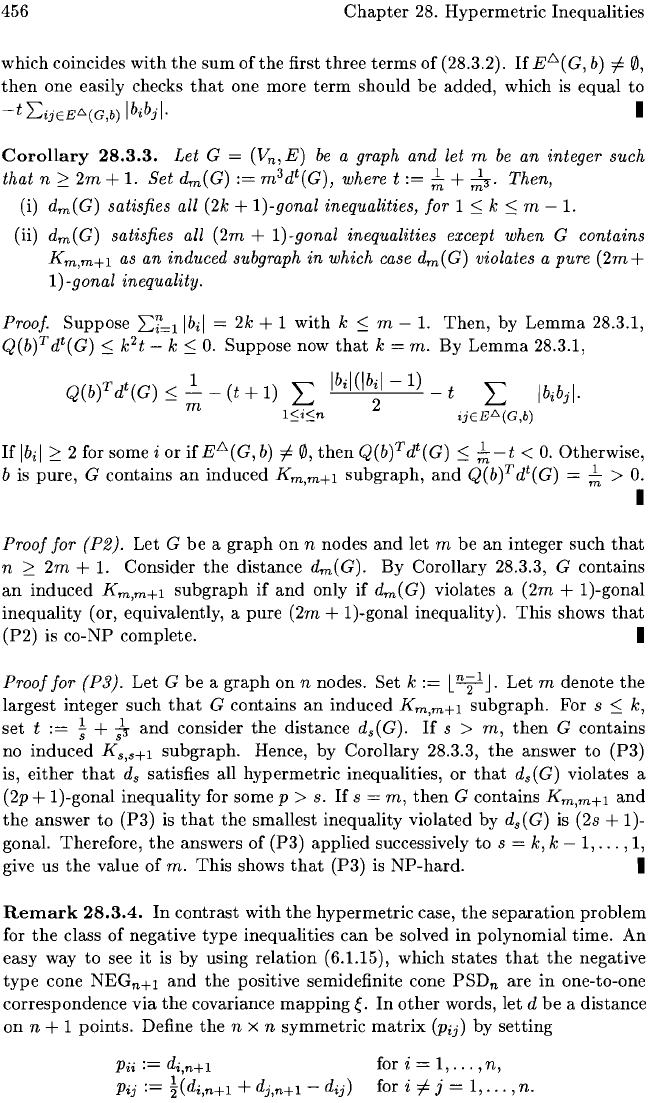
456
Chapter
28.
Hypermetric
Inequalities
which coincides
with
the
sum
of
the
first
three
terms
of
(28.3.2).
If
E/:;(G,
b)
i=
0,
then
one easily checks
that
one more
term
should be added, which is equal to
-tLijEE"'(G,b)
IMjl· I
Corollary
28.3.3.
Let G = (Vn'
E)
be
a graph and let m
be
an integer such
that n
~
2m
+ 1. Set dm(G)
:=
m
3
d
t
(G), where t
:=
~
+~.
Then,
(i)
dm(G) satisfies all (2k + I)-gonal inequalities, for 1::; k
::;
m - 1.
(ii) dm(G) satisfies all (2m + I)-gonal inequalities except when G contains
Km,m+l
as
an induced 8ubgraph in which case dm(G) violates a pure
(2m+
I)-gonal inequality.
Proof.
Suppose
L~l
Ibil
= 2k + 1
with
k
::;
m -
1.
Then,
by
Lemma
28.3.1,
Q(b)T dt(G)
::;
k
2
t - k
::;
O.
Suppose now
that
k =
m.
By
Lemma
28.3.1,
Q(bf
dt(G)
::;
~
- (t +
1)
2:
Ibil(lb;l-
1)
- t
2:
Ibibjl.
l:<O':<on
ijEE"'(G,b)
If
Ibil
~
2 for some i
or
if
E/:;(G,
b)
i=
0,
then
Q(bf
dt(G)
::;
~-t
<
O.
Otherwise,
b is pure, G contains
an
induced K
m
,m+l
subgraph,
and
Q(b)T dt(G) =
~
>
O.
I
Proof for (P2). Let G
be
a
graph
on
n nodes
and
let m be
an
integer such
that
n
~
2m
+ 1. Consider
the
distance dm(G).
By
Corollary 28.3.3, G contains
an
induced Km,m+l
subgraph
if
and
only if dm(G) violates a (2m +
I)-gonal
inequality (or, equivalently, a pure (2m + I)-gonal inequality).
This
shows
that
(P2) is co-NP complete. I
Proof for (P3). Let G
be
a
graph
on
n nodes. Set k
:=
l n;-l
J.
Let m denote
the
largest integer such
that
G contains
an
induced Km,m+l subgraph. For 8
::;
k,
set
t
:=
~
+
~
and
consider
the
distance ds(G).
If
s >
m,
then
G contains
no
induced
Ks,s+l subgraph. Hence, by Corollary 28.3.3,
the
answer to (P3)
is, either
that
d
s
satisfies all hypermetric inequalities, or
that
d
s
(G) violates a
(2p + I)-gonal inequality for some p >
8.
If
8 =
m,
then
G contains Km,m+l
and
the
answer
to
(P3)
is
that
the
smallest inequality violated by ds(G)
is
(28 + 1)-
gonal. Therefore,
the
answers
of
(P3) applied successively
to
s =
k,
k -
1,
...
,
1,
give us
the
value
of
m.
This
shows
that
(P3)
is
NP-hard.
I
Remark
28.3.4.
In
contrast
with
the
hypermetric
case,
the
separation
problem
for
the
class
of
negative
type
inequalities
can
be solved
in
polynomial time.
An
easy way
to
see
it
is
by using relation (6.1.15), which
states
that
the
negative
type
cone NEGn+l
and
the
positive semidefinite cone
PSD
n
are
in
one-to-one
correspondence
via
the
covariance
mapping~.
In
other
words, let d
be
a
distance
on
n + 1 points. Define
the
n x n
symmetric
matrix
(Pij) by
setting
Pii
:=
d
i
,n+l
fori=I,
...
,n,
Pij
:=
~(di,n+l
+ dj,n+l - dij)
for i
i=
j = 1,
...
, n.
